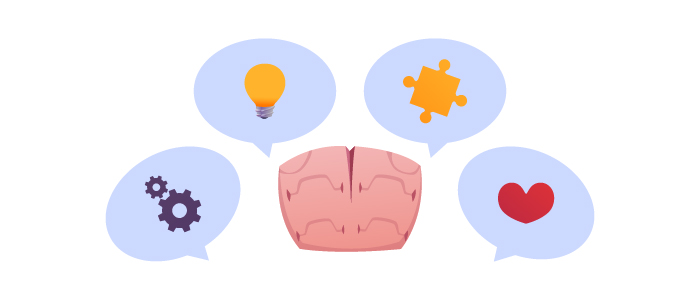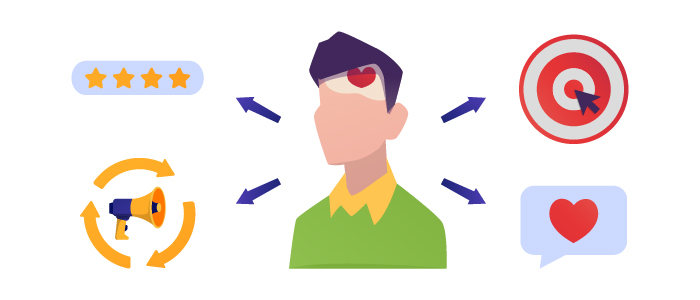Must-Knows for Using Emotional Intelligence in Marketing
Joy, anger, sadness, fear—we all experience such emotions, which is normal. In fact, it would be worrying if we did not feel emotion, right? But how do such emotions affect our behavior when buying or simply choosing something? This is where the concept of Emotional Intelligence in marketing comes in and sweeps us off our feet with its intricacies.
These days, things change surprisingly, especially in the marketing field. This is mostly due to constant technology updates and innovations in marketing processes. Once things change in the industry, our marketing strategies must also be shaped accordingly. As a result, there is one more key factor marketers must consider: consumers.
Therefore, using emotions to persuade consumers and their buying behavior ethically could be a good option. But how do we do it, right?
Stay put and take notes as today, we discuss emotional intelligence: what it is and the best practices for smoothly and successfully introducing it into your marketing strategy.
What Is Emotional Intelligence in Marketing?

Emotional intelligence (EI or EQ, from “emotional quotient”) is often considered to be the ability to perceive, use, understand, handle, and manage emotions. Basically, emotionally intelligent people can detect emotions in other people’s faces and voices and even in pictures or cultural artifacts. Furthermore, they can use emotions to complete various daily, usual activities.
Those who can manage their and others’ emotions reach one of the highest levels of emotional intelligence. They can harness specific emotions (including negative ones) to achieve their goals.
And you do not have to think of these people as manipulators who use complex and unorthodox tactics to control others. In fact, marketers, too, should be able to manage emotions, as this will help them share the brand’s values with their audience. If they do this correctly, they will harness the correct type of emotions and be one step closer to selling their products.
The Four Pillars of Emotional Intelligence
Currently, there are multiple versions of the 4 (or 5, in some cases) pillars of emotional intelligence. The most popular are self-awareness, self-management, social awareness, and relationship management.
However, considering the strong relationship between emotional intelligence and marketing, the pillars change into brand consciousness, brand management, customer consciousness, and customer engagement. And these pillars should answer some basic questions:
- Brand consciousness: Who are you? – Once you build your brand, you know who you are, what you do, and why you created this concept. Basically, this emotional intelligence pillar should reveal your brand identity and should explain why your brand is the right choice for your target audience (e.g., why they should choose you over your competitors);
- Brand management: What do you offer? – For your audience to choose your products or services, you should clearly define what is so relevant that it will captivate your potential customers and will turn them into long-term advocates;
- Customer consciousness – Who are your customers? – This pillar can somehow be considered similar to building a buyer persona. To introduce emotional intelligence in your marketing strategy, you should know some basic things about your customers. Why? Simple: because you have to build a connection with consumers, and this can only be achieved if you know users’ concerns, challenges, needs, feelings, interests, and values;
- Customer engagement: What do you do to keep your customers close? – Since we are talking about emotions, it is clear that you have to engage with consumers in a unique manner. And it is not even that hard, just slightly different. Basically, you should encourage customers to stay engaged by starting 2-way dialogues with them. You do not have to write each and every one of them, but your campaigns can be the tools that will keep customers close.
Pro Tip: Although your primary goal is to sell your services or products, build a strong connection between your brand and consumers while simply thinking of the brand-customer relationship. This practice will highly contribute to positive user experience and customer service experience. All you have to do is draw a line between building a connection and selling.
The Benefits of Emotional Intelligence in Marketing

Did you know that 53% of consumers say they feel connected when a brand’s values align with theirs, whereas 51% consider that their relationship with a brand starts when they feel the latter understands them and knows their desires?
This is how powerful emotional intelligence is when it comes to marketing. Showing emotion, even a tiny bit, can increase your success significantly. But what are the main benefits of this concept?
1. Users Will Easily Recall You
You can create the greatest ads and reach surprising numbers of users. Yet, if users cannot connect with your brand after they notice your ad due to a lack of emotions, your marketing efforts and budgets will mostly go to waste.
Moreso, a brand that integrates EQ in its marketing strategy can get consumers through the sales funnel quicker and is more likely to have more advocates and make itself easily recognizable. When you’re building strong brand-customer relationships, users feel you get them, and this includes them in the 51% we mentioned earlier.
2. It Builds and Maintains the Sense of Loyalty
A brand that understands its consumers will earn long-term, loyal customers. Loyalty is based on emotions, and emotional intelligence can harness such feelings. A loyal customer will surely stay close to a brand for a long period.
Imagine that brand A manufactures and sells sportswear and accessories and designs its products simply based on the team’s ideas without considering what consumers need. A hiking backpack may have a single compartment with no other smaller pockets.
On the other hand, a similar brand B that communicates with its customers and builds a strong connection with them would discover that consumers need a product with more pockets so that everything stays still while moving. Furthermore, the company constantly communicates with its customers to find out more about their needs and how they can meet them. This would surely keep customers closer to brand B, as B’s products would be designed with users’ needs in mind.
3. Encourages Users to Take Action
Consumers’ buying decisions are emotion-driven. This is why you should tie buying decisions to an emotional trigger.
Daniel Goleman explains this concept in “Emotional Intelligence: Why It Can Matter More than IQ.” According to Goleman, every individual has 2 minds: rational and emotional. They operate simultaneously and represent 2 things we always discuss: the heart (emotional) and the head (rational). The head depends on the heart and vice versa.
However, as much as we like to believe that the head, thus the rational mind, is the one that makes the decisions, this concept is far from the truth. In fact, it is the other way around. The emotional mind is the first to feed the rational with emotions, and even if the rational filters the emotions, the impulse still comes from the emotional mind. Daniel Goleman states, “It is the emotional mind that captures the upper hand, swapping the rational mind.”
Thus, introducing emotional intelligence in your marketing strategy can harness positive emotions and encourage users to take action. Your main goal should be to trigger the emotional mind, as this will also involve the rational mind in the decision-making process.
4. Adds Humanity to Marketing Processes
These days, marketing is often seen as a rather technical field. And it is. However, marketers still communicate with humans. So, as technical as marketing might be, human connection can still significantly increase sales.
And this is what emotional intelligence does. Basically, delivering and receiving emotions adds a surprising level of “humanity” to the marketing process, which may be one of the best benefits of this practice.
How to Use Emotional Intelligence in Marketing?

Introducing EQ in your marketing strategy can have significant benefits. But how to do that? Well, here are some practices that will help you achieve that seamlessly.
1. Increase Self-Awareness
To share your emotions, you should know exactly who you are. Users care more about you and your brand rather than the products. Do not get scared; they also care about your products. Otherwise, why would they buy them? But we are trying to say that a consumer will only buy your products if you are trustworthy and they can relate to you.
Let’s think of an example. You have a brand named T, and you sell various types of tea from all over the world. You must understand your brand the best before waiting for customers to understand it. So, try to answer some “WH”-questions.
- Who Are You? – You are T, the company that prepares and sells numerous types of tea;
- What Do You Do? – You prepare various types of specialty tea, including black, oolong, green, yellow, white, and many other blends. The specialty teas are carefully prepared and stored so that no factors can affect their flavor and quality;
- Why Do You Do This? – With a passion for specialty teas, you aim to share some of the most noble blends with your customers. You focus on high quality to surprise your customers with powerful flavors and a scent that can warm every heart;
- Where Do You Do This? – Your teas are available on your website, where users can have an intriguing journey, thanks to your well-organized content and extensive information about every product available.
2. Shape Your Goal Accordingly
Every brand should have a goal. Otherwise, why would you put so much effort into your brand’s success? So, try to carefully shape your goal so that it is achievable and easily understood by others.
If you express what you want to achieve, you can shape the campaign to make customers understand and relate to you. When your goal is clear, not only do you have the motivation to work towards it, but you can also share some emotions with your audience.
Let’s get back to T. What is its goal? Well, to set a goal for T, you can get back to the “Why” question you answered earlier. Considering your passion for specialty teas, you want to share some flavorful, high-quality blends with your customers.
With your goal in mind, your marketing efforts should be focused on achieving it. And when you are honest about your goal, your audience will be more than eager to help you achieve it.
3. Be Empathetic and Build a Relationship with Your Audience
To introduce emotional intelligence in marketing strategies, you must empathize with your audience. A brand that doesn’t care about its customers and is not connected to them will have much to lose, while another that is always interested in what its customers think and need can quickly achieve success.
When achieving your goal, try to think about your audience rather than your motives. While still keeping your goal in mind, focus on how to make your customers feel cared for. And we are not only talking about giving them a discount.
Always try to find out more about your customers, such as what they like about your products and what they would change if they were you. A brand that cares for its customers is a brand that succeeds.
4. Base Your Campaigns on EQ
We are not saying you should only consider EQ when building a campaign. Instead, we advise you to introduce emotional intelligence in your long-term marketing strategy. Using emotional intelligence to build a connection with your customers should always be a key practice. It is all about consistency and, most importantly, constancy.
If you build a relationship with a customer, you should maintain it by constantly checking their needs and feedback. If not, it is highly possible that they will not relate to your brand anymore and will look for other options on the market in the hope that another brand will understand them better.
5. Be as “Human” as Possible
To use EQ to your advantage, you must prove that you are a human being, figuratively speaking. Don’t let a computer, laptop, or phone stay in the way of connecting with your audience emotionally.
Having good copy and strong CTAs is great, but you can always try adding some emotion here and there. This will prove to consumers that the person behind the ads, posts, or even customer support is a human being. Consumers who connect with a brand are more likely to become loyal.
Tips for Introducing EQ in Your Marketing Strategy

1. Don’t Fake It
Like in many other situations, users can feel if you don’t pay attention to them and only communicate to achieve your goal. Stay true to them and focus on finding what you can do to improve your customer connection.
This will help you build a brand-customer relationship that will last longer and bring you more than you could imagine. If you maintain your connection with your customers, they will return to you whenever they need your product. This practice requires smaller marketing budgets, as you already have some customers that stay close.
2. Trigger the Right Emotion(s)
There is one thing we have not mentioned yet. It is important to harness emotions, but you should always focus on what emotions you get from consumers. If your customers are concerned or furious, this will surely not help you.
You should harness the right emotion to make a consumer buy something. As we mentioned, you must give the mind an emotional trigger. For a better view, imagine that there are 8 types of basic emotions: anger, sadness, fear, enjoyment, love, surprise, disgust, and shame.
What emotions should you look for? Well, the buying decision is a blend of basic emotions. Thus, you should harness an emotion that combines enjoyment (joy and satisfaction) and love (trust).
2. Focus on Creating a Positive First Impression
We all know that the first impression matters greatly, as it becomes a pillar of how somebody looks at you. The first impression is formed pretty quickly, in less than 1 second, to be precise, according to Google’s research.
So, focus on catching users’ attention in the first second. If you harness a positive emotion in that time, your connection with a customer might be easier to build and maintain.
3. Make Customers Part of the Brand’s Story
Consumers love to be part of a brand’s story, and this is not surprising at all. Users like to feel they are part of something’s evolution, even though they do not contribute directly.
Take Apple’s example. Apple focuses on clean designs and simplicity, and this can harness a desire to become part of a lifestyle movement. Such concepts awaken one of the basic emotional needs of us all: to be part of something bigger. It is exactly like religions or other social movements.
Make customers part of your brand’s story, and the feeling they get will keep them close and loyal.
Final Thoughts
Emotional intelligence in marketing means the ability to use, harness, and manage emotions. Through EQ, we can build connections with other people or a brand.
If you aim to introduce emotional intelligence in marketing strategies, always focus on the 4 pillars of emotional intelligence: brand consciousness, brand management, customer consciousness, and customer engagement. This way, you will know where to start with this practice.
To introduce EQ in your marketing strategy, try to focus on self-awareness, building an achievable goal, empathizing with the audience, and communicating like a human without being affected by the channel you use. Also, always work to improve your communication skills.